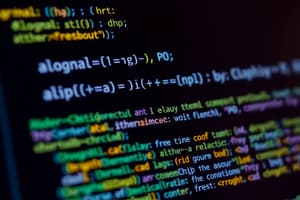Podcast
Questions and Answers
What is an algorithm?
What is an algorithm?
A procedure used for solving a problem or performing a computation, acting as a list of instructions.
Which of the following is not an example of an algorithm in everyday life?
Which of the following is not an example of an algorithm in everyday life?
- Choosing a Movie on Netflix (correct)
- Tying Your Shoes
- Finding a Library Book
- Following a Recipe
Pseudocode cannot be compiled nor executed as it is only meant to be read by _____.
Pseudocode cannot be compiled nor executed as it is only meant to be read by _____.
humans
Pseudocode is also known as false code.
Pseudocode is also known as false code.
What should you use appropriate naming conventions in pseudocode?
What should you use appropriate naming conventions in pseudocode?
Which structure is not mentioned as a standard programming structure in pseudocode?
Which structure is not mentioned as a standard programming structure in pseudocode?
What is a flowchart?
What is a flowchart?
In a flowchart, the symbol for a process is typically a _____.
In a flowchart, the symbol for a process is typically a _____.
Provide an example of a program that can be illustrated using a flowchart.
Provide an example of a program that can be illustrated using a flowchart.
Flashcards are hidden until you start studying
Study Notes
Algorithm
- A systematic procedure for solving problems or performing computations.
- Functions as a step-by-step guide in both hardware and software contexts.
- Everyday examples include:
- Tying shoes
- Following recipes
- Classifying objects
- Bedtime routines
- Locating library books
- Navigating (driving directions)
- Deciding meals
Pseudocode
- A method for writing algorithms using natural language, typically English.
- Intended for human readability, it cannot be compiled or executed.
- Also referred to as "false code."
- Guidelines for writing pseudocode:
- Start with a clear goal statement.
- Arrange tasks in sequence.
- Indent control structures like if-else and loops for clarity.
- Use meaningful and distinct names to enhance understanding.
- Employ standard programming structures (e.g., if-then, for, while, cases).
- Ensure pseudo code is simple and comprehensible to non-technical users.
- Avoid overly technical terms and keep it clear and finite.
Flowchart
- A visual representation of a process, system, or algorithm.
- Illustrates a program's functions in sequence, separate from the data processed.
- Serves as a graphical tool to understand actions and decision processes within a program.
Flowchart Examples
- Design a flowchart for displaying "Hello World."
- Create a flowchart that adds two user-inputted numbers.
- Construct a flowchart to evaluate whether a user's grade is a "pass" or "fail" (passing grade is 75).
Studying That Suits You
Use AI to generate personalized quizzes and flashcards to suit your learning preferences.




